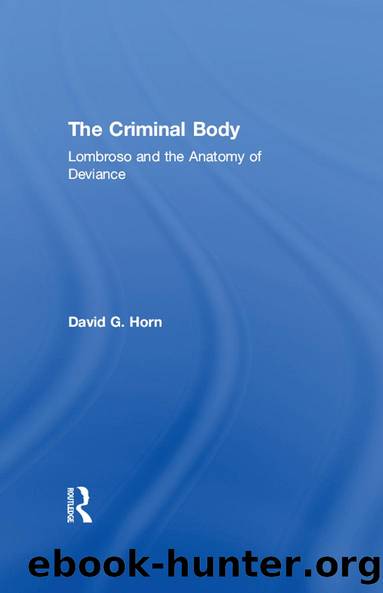The Criminal Body by David Horn

Author:David Horn [Horn, David]
Language: eng
Format: epub
Tags: Social Science, Criminology, Sociology, General
ISBN: 9780415947299
Google: hzPNlQnnkGUC
Publisher: Psychology Press
Published: 2003-01-15T05:59:44+00:00
II. The Natural History of the Blush
Attention to blushing gained a new seriousness with the publication in 1872 of Darwinâs The Expression of the Emotions in Man and Animals, but the blush had already been a topic of both literary and scientific interest.15 Like pain (Chapter 4), the blush was part of a conversation about what it meant to be human, and about the contradictory effects of being or becoming civilized. This was a conversation that had everything to do with race, imperialism, and the power of scientists and others to manipulate bodies.
For some time, blushing had served as a link between the surface of the body and interior states, the visible sign of a conscience. As Janet Browne remarks, in the mid-nineteenth century it was imagined that only blushing could prove that men and women had a conscience: âOnly the hot flush of embarrassment could establish that people had the ability to reflect upon themselves and their behavior, were alive to their situation, could feel self-conscious in the literal sense of that term. Completely bypassing the will, and surfacing despite all our efforts to subdue it, blushing was seen to be a direct manifestation of our innermost thoughts and feelings. It was a window to the soul far more revealing than those other windows, the eyes.â16
But the blush became an object of scientific scrutiny as well with the publication of Thomas Henry Burgessâ The Physiology or Mechanism of Blushing in 1839.17 For the physician Burgess (d. 1865), blushing was interesting as an example of âan involuntary act of the mind upon the vital organs and their several functions.â18 In what Browne identifies as a natural theological argument, Burgess claimed that blushing was both uniquely human and had been designed by the creator in âorder that the soul might have sovereign power of displaying in the cheeks the various internal emotions of the moral feelings.â19
Yet modernity had brought with it an acquired sensibility that Burgess likened to a diseased state; examples included young men who were âsensitive, timid and abashed in society.â20 Refinement and civilization had âperverted the original intentâ of blushing, such that it was now âdifficult to judge whether the blush be from an impulse of shame, or merely from a sensibility that is overwrought.â21 Civilization was marked by the âuncalled-for blush,â due to an âirritability of the sensorium arising from an over refinement, and want of early education.â22 By contrast, the blush of the unrefined savage was authentic, as well as more easily legible:
Who ever heard of an American savage blushing from morbid sensibility? and yet is he on this account the less liable to the impulse of shame or disgrace, according to his own views or interpretations of such feelings? No! the change of colour in him is a genuine example of moral instinct.23
By contrast, Burgess did assert the inability of the âcongenital idiotâ to blush, not because of a somatic (vasomotor) defect, but because of his lack of reasoning power.24
Burgess also confronted the claim made
Download
This site does not store any files on its server. We only index and link to content provided by other sites. Please contact the content providers to delete copyright contents if any and email us, we'll remove relevant links or contents immediately.
The 1921 Tulsa Race Massacre by Chris M. Messer(286)
Introduction to Criminal Justice - A Balanced Approach by Brian K. Payne Willard M. Oliver Nancy E. Marion(254)
Punishing the Poor The Neoliberal Government of Social Insecurity by Unknown(249)
Russia's Sakhalin Penal Colony, 1849â1917 by Andrew A. Gentes(248)
The History of Newgate Prison by Jowett Caroline;(235)
Serial Killers America and UK - 2 BOOKS IN 1 by Clark Matthew(210)
A History of Police and Masculinities, 1700-2010 by David G. Barrie Susan Broomhall(195)
Restorative Justice in Transitional Settings by Kerry Clamp(168)
Organized Crime and Corruption Across Borders by T. Wing Lo Dina Siegel Sharon I Kwok(158)
Culture, Crime and Punishment by Ronald Kramer(155)
Cops, Cameras, and Crisis by Michael D. White Aili Malm(154)
Dangerousness, Risk and the Governance of Serious Sexual and Violent Offenders by Karen Harrison(152)
Policing Gender, Class And Family In Britain, 1800-1945 by Linda Mahood(151)
Routledge Handbook on Immigration and Crime by Holly Ventura Miller Anthony Peguero(151)
The Real CSI by Kate Bendelow(149)
Women Exiting Prison by Bree Carlton Marie Segrave(140)
Losing Legitimacy by Gary Lafree(138)
Using Murder by Philip Jenkins(136)
A Theory of African American Offending by James D. Unnever Shaun L. Gabbidon(134)
